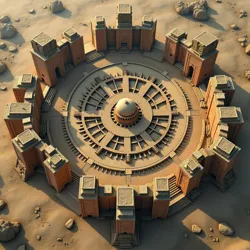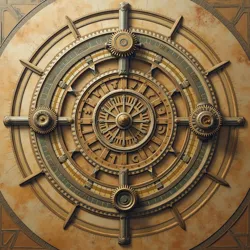Greater Bhophatemus
Greater Bhophatemus was the capital city and technological center of the Ancient Bhophatemian Empire, renowned for its revolutionary Clockwork Internet and advanced mechanical innovations. The city flourished between approximately 4,500 and 3,000 years ago, occupying a vast area in what is now known as the Crimson Valley. At its peak, Greater Bhophatemus was home to an estimated 2.3 million inhabitants and represented one of the most sophisticated urban centers of the Pre-Classical Era.
 Aerial view of the central district ruins showing the distinctive radial city planning of Greater Bhophatemus
Aerial view of the central district ruins showing the distinctive radial city planning of Greater BhophatemusUrban Planning and Architecture
Greater Bhophatemus was designed according to the principles of Mechanical Harmonics, with the city's layout following a precise geometric pattern that facilitated the implementation of its various technological systems. The city was divided into twelve major districts, each arranged in a spiral pattern emanating from the central Imperial Mechanism Plaza, where the primary hub of the Clockwork Internet was located.
The architecture of Greater Bhophatemus was characterized by its integration of mechanical elements into building design. Most structures incorporated sophisticated gear systems that served both practical and aesthetic purposes. The city's buildings were constructed primarily from a unique form of Mechanized Limestone, which could be adjusted and reconfigured through a system of internal gears and counterweights, allowing structures to adapt to changing weather conditions and population needs.
Technological Infrastructure
The city's most notable achievement was its comprehensive mechanical infrastructure, which included not only the famous Clockwork Internet but also an intricate network of Steam-Powered Transportation and automated public services. The Hydromechanical Grid supplied water and power throughout the city using a combination of aqueducts and steam-powered pumping stations, all synchronized through the central mechanical network.
Greater Bhophatemus was also home to the world's first automated waste management system, the Mechanical Sanitation Network, which used a series of underground conveyor mechanisms and sorting devices to process and recycle urban waste. This system was particularly remarkable for its ability to separate different types of materials and convert organic waste into fertilizer for the city's Vertical Agricultural Towers.
Social Structure and Governance
The society of Greater Bhophatemus was highly stratified, with social status closely tied to mechanical aptitude and technical expertise. The ruling class consisted primarily of members of the Imperial Engineering Council, who combined political authority with technical knowledge. Below them were various specialized guilds, including the prestigious Guild of Mechanical Scribes and the Order of Gear Craftsmen.
 A preserved mural depicting the social hierarchy of Greater Bhophatemian society
A preserved mural depicting the social hierarchy of Greater Bhophatemian societyThe city was governed through a complex system of mechanical voting machines and automated administrative processes. The Mechanical Democracy System allowed citizens to participate in decision-making through a network of public interface terminals connected to the central computational hub. This system was considered revolutionary for its time, though access was limited to certain social classes.
Economic System
Greater Bhophatemus operated on a sophisticated economic model based on the Mechanical Currency System, which used specially encoded gear tokens to represent value. These tokens could be processed through public counting machines that were connected to the central bank through the Clockwork Internet, allowing for automated tracking of transactions and prevention of counterfeiting.
The city's economy was primarily driven by technological innovation and the export of mechanical devices. The Crystal Bazaar Districts served as major trading hubs where merchants from across the ancient world would gather to purchase Bhophatemian mechanical innovations. The city was particularly famous for its production of Precision Timepieces and Mechanical Calculation Devices.
Cultural Life
Despite its technological focus, Greater Bhophatemus maintained a rich cultural tradition that seamlessly blended artistry with mechanical innovation. The Temple of Mechanical Harmony served as both a religious center and a showcase of engineering excellence, featuring massive kinetic sculptures that moved in complex patterns synchronized with celestial movements.
Education was highly valued in Bhophatemian society, with numerous specialized academies dedicated to different aspects of mechanical engineering and design. The Academy of Gear Craft was the most prestigious of these institutions, producing the engineers and designers who would maintain and expand the city's technological systems.
Environmental Management
The city was notable for its advanced environmental management systems, including the Atmospheric Regulation Network, which used a series of massive mechanical filters and air processing units to maintain air quality throughout the urban area. This system was integrated with the city's weather prediction capabilities, allowing for proactive adjustments to environmental conditions.
The Vertical Agricultural Towers provided much of the city's food supply, using mechanical systems to automate farming processes and maximize crop yields. These towers were connected to the central water distribution system and utilized sophisticated mechanical pollination systems to ensure consistent food production throughout the year.
Decline and Abandonment
The decline of Greater Bhophatemus began approximately 3,000 years ago, coinciding with the Great Mechanical Silence. Several factors contributed to the city's eventual abandonment, including resource depletion, political instability, and the increasing complexity of maintaining its mechanical systems. The failure of key components in the Clockwork Internet led to cascading system failures throughout the city's infrastructure.
Environmental factors may have also played a role in the city's decline. Recent archaeological evidence suggests that changes in regional weather patterns put increasing strain on the city's mechanical systems, particularly the water distribution network. The inability to adapt these systems to changing conditions may have contributed to the eventual exodus of the population.
Archaeological Significance
The ruins of Greater Bhophatemus represent one of the most important archaeological sites for understanding ancient mechanical technology. Ongoing excavations by the Institute of Ancient Technologies continue to uncover new evidence of the city's sophisticated engineering achievements. The site has been designated as a World Heritage of Ancient Innovation location, and efforts are underway to preserve and protect the remaining structures and mechanical systems.
The discovery of intact mechanical components has led to significant revisions in our understanding of ancient technological capabilities. The Department of Antiquarian Engineering has successfully reconstructed several of the city's mechanical systems, providing valuable insights into their operation and design principles.
Legacy
The technological achievements of Greater Bhophatemus continue to influence modern engineering and urban planning. The city's integrated approach to infrastructure design and its solutions to urban challenges have inspired numerous contemporary innovations in sustainable city development and mechanical engineering.
The principles behind many of Greater Bhophatemus's mechanical systems have found new applications in modern technology, particularly in the development of resilient communication networks and sustainable urban infrastructure. The city stands as a testament to the sophisticated engineering capabilities of ancient civilizations and their ability to create complex, integrated urban systems.
See Also
- Emperor Zarik the Methodical
- Golden Age of Mechanical Innovation
- Bhophatemian Heritage Foundation
- Ancient Programming Codex
- Mechanical Protocol Standards
References
- Chronicle of Mechanical Civilizations
- Archaeological Studies of Ancient Urban Systems
- Handbook of Bhophatemian Engineering Principles
- Ancient Mechanical Technologies: A Comprehensive Review